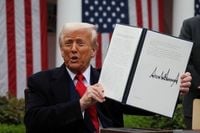As the United States awaits a pivotal Supreme Court decision on presidential tariff powers, the Trump administration is quietly laying the groundwork for a series of fallback options that could reshape the nation’s trade policy for years to come. With the court’s judgment expected any day, officials in the White House, the Commerce Department, and the Office of the U.S. Trade Representative are working feverishly behind the scenes to ensure that President Trump’s signature approach to tariffs endures, even if the justices rule against his current authorities.
According to Bloomberg, the administration’s preparations are far from theoretical. U.S. officials familiar with the planning confirm that both the Commerce Department and the U.S. Trade Representative have closely studied alternative legal avenues—most notably Section 301 and Section 122 of the Trade Act—that could allow the president to continue imposing duties on foreign imports. These provisions, while potent, come with significant limitations and risks compared to the broad powers Trump has wielded so far.
Section 301, for example, empowers the U.S. Trade Representative to investigate and address unfair trade practices by foreign countries that harm U.S. commerce. It requires a thorough investigation before any duties can be imposed, a process that tends to move at a slower pace than the sweeping tariffs enacted under the International Emergency Economic Powers Act (IEEPA). Section 122, meanwhile, allows the president to impose tariffs of up to 15% for a maximum of 150 days—a threshold President Trump has reportedly agreed upon in various negotiations. However, this authority is also more constrained and temporary by design.
Despite these hurdles, the administration’s resolve is clear. As one official told Bloomberg, “Tariffs remain a core part of the U.S. President’s agenda, regardless of the court’s decision.” The White House itself has acknowledged that it is “seeking new ways” to maintain Trump’s trade policy, though it has declined to offer specifics about the backup plans. Spokesman Kush Desai stated, “President Trump lawfully exercised the emergency tariff powers granted to the Executive Branch by Congress, and the Administration is confident in ultimate victory on this matter by the Supreme Court. The Administration is always examining new ways to address America’s historic goods trade deficit and reshore the manufacturing that’s critical to our national and economic security.”
For President Trump, the stakes are high. He has repeatedly urged the justices to uphold the tariffs he imposed by citing an economic emergency, arguing that these measures are essential to protecting American industry and jobs. “We’re waiting for a decision. We hope it’s going to be good, but if it’s not, we’ll do — we always find ways, you know, we find ways,” Trump said Wednesday, according to Bloomberg. The administration’s hope, of course, is that the court will side with them, but the preparations signal a clear recognition that an unfavorable outcome is a real possibility.
The Supreme Court case centers on Trump’s use of the IEEPA to enact reciprocal tariffs on imports from around the globe, as well as targeted levies on Chinese, Canadian, and Mexican goods. The administration has even slapped a charge on products from Brazil in an unsuccessful attempt to halt the prosecution of former president and Trump ally Jair Bolsonaro. The total effective tariff rate on U.S. imports now stands at roughly 14.4%, with more than half attributed to IEEPA duties, Bloomberg Economics estimates. If the Supreme Court invalidates these country-based tariffs, “most duties [are expected] to eventually be fully replaced,” according to the same analysts.
Yet replacing them won’t be easy. The fallback options—Sections 301, 122, and others—are generally slower to implement, more limited in scope, and likely to encounter their own legal challenges. For instance, Section 338 of the Tariff Act, which has never been used before, could theoretically allow the president to impose tariffs of up to 50% or exclude imports from countries that discriminate against the U.S., but its untested status makes it a legal minefield. National Economic Council Director Kevin Hassett has acknowledged the complexity of the situation, telling Bloomberg, “There are a lot of things that we could do so that we could reproduce the policies that we have right now with alternative authorities.”
In practice, the administration has already started rolling out some of these backup plans. Trump has initiated a Section 301 investigation against Brazil and has reimposed 301 tariffs on certain Chinese products, echoing actions from his first term. These moves are not without precedent; Trump has previously used Section 232 of the Trade Expansion Act to levy tariffs on metals and autos. But each provision comes with its own set of procedural requirements and political ramifications. For example, Section 301 typically demands an extensive investigation before duties can be imposed, while Section 122’s 150-day limit poses enforcement challenges—especially if the administration seeks to reimpose or retroactively apply duties to avoid refunding billions already collected.
Indeed, the financial stakes are enormous. Should the Supreme Court rule against the administration, officials may be forced to return more than $88 billion in duties already collected, according to Bloomberg Economics. This prospect alone has injected a fresh dose of uncertainty into an already volatile trade landscape, leaving businesses and foreign governments scrambling to anticipate their next moves.
Complicating matters further, the ongoing inclusion of finished products under Trump’s tariffs has ruffled feathers among key trading partners, including the European Union. EU officials argue that these measures violate the agreed-upon limits on sector-specific tariffs within the U.S.-European Union trade agreement, raising the specter of retaliatory action and further trade tensions.
With the Supreme Court’s decision still pending—no one is quite sure when it will arrive—the business community and America’s trading partners are left in a state of limbo. The justices could uphold the tariffs, strike them down entirely, or opt for a more nuanced approach, each path carrying its own set of consequences. For now, the only certainty is uncertainty.
What’s clear is that President Trump and his advisers are determined to keep tariffs at the heart of U.S. trade policy, come what may. Whether through existing authorities, novel legal strategies, or sheer persistence, the administration is signaling that it will not simply abandon its approach if the Supreme Court delivers a setback. As the nation waits for the court’s verdict, one thing is certain: the fight over tariffs is far from over, and the outcome will reverberate through the global economy for years to come.





